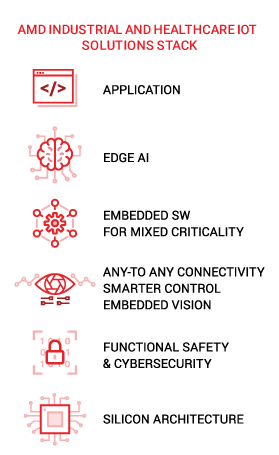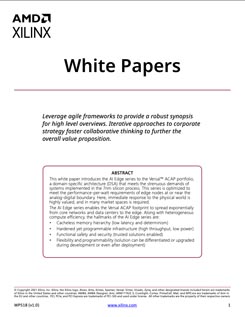- Applications
- Industrial
- OS/RTOS & Hypervisors/Containers
OS/RTOS & Hypervisors/Containers
AMD SoCs and FPGAs support wide selection of operating systems, embedded cloud infrastructures, and software isolation tools
AMD supports a wide offering of operating systems (OS) and real-time operating systems (RTOS), including support for the popular Yocto-based Linux. A common architecture among many IIoT edge embedded devices is a dual OS and RTOS approach to support IT/OT convergence. In this scenario, IT functions are performed within the boundaries of an OS, most commonly Linux on an application processor, with the OT functions performed within the boundaries of Linux with the PREEMPT_RT modifications, an RTOS, or FPGA hardware. In some cases, the RTOS runs on a real-time processor core and in other cases, it is desirable for both IT and OT functions to run on application processors due to performance, feature set, and ease of supporting one homogenous processor architecture.
Ubuntu 20.04 Desktop Version is supported on Kria KV260 Vision AI Starter Kit and on ZCU102, ZCU104, ZCU106 AMD Development Kits. Check out the press release.
However, control over application processing behaviors has attracted a lot of attention from Industrial IoT developers due to the deterministic requirements of Industrial tasks intersecting the inherently non-deterministic behavior of application processors, caches, and the applications themselves. Different approaches have been researched and adopted to maximize the both the capability and suitability of today’s modern single to multi-core embedded processors, many of which are supported by AMD adaptive SoCs.
One approach is through isolation: hypervisors isolate operating systems, containers isolate applications. Both create virtualized boxes that offer some degree of immunity from the behaviors of other boxes that may exist, which sometime contain independently-written 3rd party content that has not been tested for interoperability or stability.
Other approaches involve making use of the low level hardware architecture to monitor and control behavior, as is employed with unsupervised asymmetric processing (AMP) and cache coloring techniques. AMP uses multiple processors with precise control over what runs on each processor. Cache coloring is a hybrid approach that, often in conjunction with a hypervisor, enables exclusive access to the cache by a single processor core reducing the impact on timing of a cache eviction.
Popular Embedded Software Constructs for Industrial Applications |
More information |
|---|---|
OS & Hypervisors |
Embedded Software |
Container Support |
|
Unsupervised Asymmetric Multiprocessing (AMP) |
|
Cache Coloring |
|
AMD Support for AWS Greengrass Clients |
|
AMD Support for Azure Clients |

Some Industrial and Healthcare IoT products need all elements of the AMD IIoT and HcIoT Solutions Stack, all need some. The AMD IIoT and HcIoT Solutions Stack is comprised of optimized AMD and Ecosystem building blocks and solutions used across Industrial and Healthcare IoT platforms. Starting from scratch is never something you will have to do with a AMD-based Industrial or Healthcare IoT system. Minimize development time and cost and maximize design reuse on your next Industrial or Healthcare IoT platform by exploring the different elements of the AMD IIoT and HcIoT Solutions Stack.



